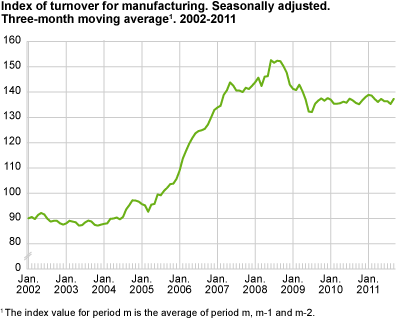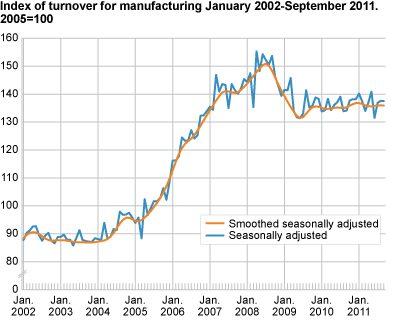Content
Published:
This is an archived release.
Minor changes in industrial turnover
Seasonally-adjusted figures show a small increase of 0.7 per cent in the turnover in Norwegian manufacturing from the second quarter of 2011 to the third quarter of 2011.
Most of the industries within the Norwegian manufacturing sector showed small changes in the third quarter. However, two industries showed better turnover results. Machinery and equipment went up 16 per cent. An increase in new orders has resulted in an increased production volume, which explains this positive development. See the Index of production . Turnover within food products also went up; by 2.8 per cent in the same period.
Meanwhile, the turnover within building of ships, boats and oil platforms fell by 15 per cent in the third quarter due to lower activity within the industry.
Unchanged turnover from August to September 2011
Seasonally-adjusted figures showed that the turnover in Norwegian manufacturing was unchanged from August to September this year. Turnover within basic metals dropped 2.6 per cent due to continued price falls several months in succession. See the Producer price index .
Increase from September 2010
Unadjusted figures showed that the total manufacturing turnover went up 3.6 per cent since the same month last year.
The largest contribution came from non-ferrous metals, up 8.9 per cent. In addition, rubber, plastic and mineral products showed a 3.8 per cent increase. The largest per cent change within refined petroleum, chemicals and pharmaceuticals has to be viewed in conjunction with the planned shutdown in the refined petroleum industry in September last year, which reduced the turnover in this period.
Industries with lower turnover were repair and installation of machinery; down 25 per cent, followed by building of ships, boats and oil platforms, with a 19 per cent decrease.
| Original series.1
January-September 2011 |
Changes in per cent. January-September 2010- January-September 2011 |
Original series.1
September 2011 |
Changes in per cent. September 2010- September 2011 |
Changes in per cent. Seasonally adjusted. April 2011-June 2011- July 2011-September 2011 |
|||||||||||||||||||||||||||||||||||||||||||||||||||||||||||||||||||||||||||
|---|---|---|---|---|---|---|---|---|---|---|---|---|---|---|---|---|---|---|---|---|---|---|---|---|---|---|---|---|---|---|---|---|---|---|---|---|---|---|---|---|---|---|---|---|---|---|---|---|---|---|---|---|---|---|---|---|---|---|---|---|---|---|---|---|---|---|---|---|---|---|---|---|---|---|---|---|---|---|---|
| The overall turnover | 1 162 324 | 8.2 | 135 354 | 12.2 | 5.9 | ||||||||||||||||||||||||||||||||||||||||||||||||||||||||||||||||||||||||||
| Extraction and related services | 487 878 | 19.8 | 55 388 | 29.4 | 12.1 | ||||||||||||||||||||||||||||||||||||||||||||||||||||||||||||||||||||||||||
| Manufacturing, mining and quarrying | 565 112 | 1.0 | 70 308 | 4.2 | 0.5 | ||||||||||||||||||||||||||||||||||||||||||||||||||||||||||||||||||||||||||
| Domestic market | 331 206 | -5.1 | 41 843 | -3.3 | 0.5 | ||||||||||||||||||||||||||||||||||||||||||||||||||||||||||||||||||||||||||
| Export market | 233 905 | 11.2 | 28 465 | 17.7 | 2.6 | ||||||||||||||||||||||||||||||||||||||||||||||||||||||||||||||||||||||||||
| Electricity, Gas and Steam Supply | 109 333 | 1.5 | 9 658 | -7.1 | -0.7 | ||||||||||||||||||||||||||||||||||||||||||||||||||||||||||||||||||||||||||
| Main industrial groupings | |||||||||||||||||||||||||||||||||||||||||||||||||||||||||||||||||||||||||||||||
| Intermediate goods | 274 360 | 11.9 | 33 963 | 7.3 | 2.2 | ||||||||||||||||||||||||||||||||||||||||||||||||||||||||||||||||||||||||||
| Capital goods | 143 803 | -15.2 | 17 706 | -10.9 | -2.1 | ||||||||||||||||||||||||||||||||||||||||||||||||||||||||||||||||||||||||||
| Consumer goods | 141 063 | -0.2 | 18 451 | -0.8 | 0.0 | ||||||||||||||||||||||||||||||||||||||||||||||||||||||||||||||||||||||||||
| Energy goods | 603 097 | 16.3 | 65 234 | 29.1 | 9.7 | ||||||||||||||||||||||||||||||||||||||||||||||||||||||||||||||||||||||||||
| 1 | NOK million. |
Interpretation of seasonally-adjusted figuresIn order to facilitate the interpretation of the short-term development, statistics on turnover publishes three-month moving averages of the seasonally-adjusted figures. We normally compare the latest non-overlapping three-month periods (for instance May to June compared with July to September). |
The relationship between production and turnoverThe development in the turnover can be related to changes in both volume and prices in the different industries. Production to stocks and sales from stocks can also happen. Reporting during large deliveries of capital goods can contribute to differences in the development in the index of production and the statistics on turnover. Tables |
Find more figures
Find detailed figures from Turnover in oil and gas, manufacturing, mining and electricity supply
Additional information
The variation in manufacturing turnover can be related to changes in volume and price indices in different industries and also production to stocks and sales from stocks.
Contact
-
Robert Skotvold
E-mail: robert.skotvold@ssb.no
tel.: (+47) 40 90 24 44
-
Anne Karin Linderud Haugen
E-mail: anne.karin.linderud.haugen@ssb.no
tel.: (+47) 91 88 19 76


